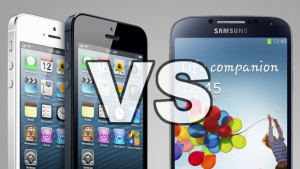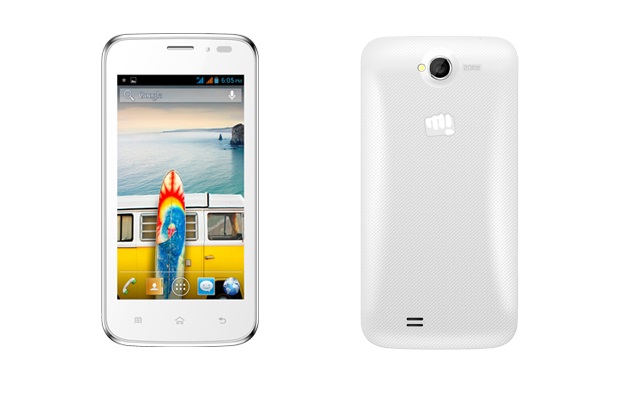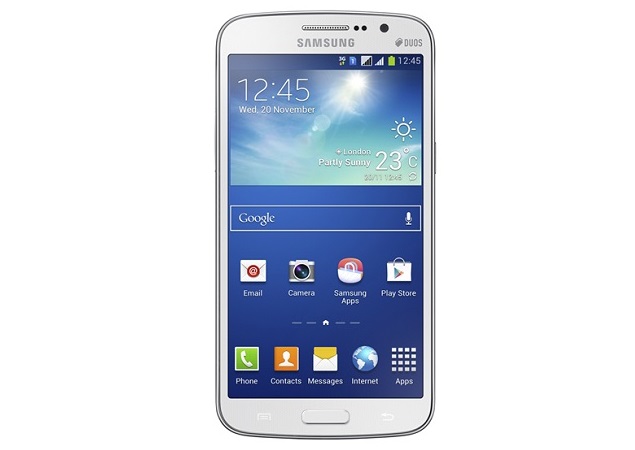Samsung Galaxy S4 vs iPhone 5 – Design
 Samsung Galaxy S4 – 7.7mm thick, plastic rear
Samsung Galaxy S4 – 7.7mm thick, plastic rear
iPhone 5 – 7.6mm thick, aluminium rear
Unlike comparing the Samsung Galaxy S4 with its Android rivals, where body shapes and sizes are similar at this high-end level, the Galaxy S4 and iPhone 5 are completely different.
It may sound trivial, but one of the most important design differences is that the Galaxy S4 is over 1cm wider than the iPhone 5. This makes it much trickier to grasp reliably than the iPhone, which is intended to fit comfortably into the hand of just about anyone.
When changing the design from the iPhone 4S to the iPhone 5, Apple elongated the screen rather than making it any wider for precisely this reason.
Although the Galaxy S4 is much larger than the iPhone 5, it’s not actually any thicker – well it’s 0.1mm thicker, but even in the slimness-obsessed phone world that’s not worth crowing about.
The Samsung Galaxy S4 has a curvier body than the iPhone, which feels harder and more severe thanks to its aluminium shell and immaculate bevelled edges. Conversely, there’s no metal on the Galaxy S4’s exterior.
Its front is top-notch Gorilla Glass, but the rest is plastic. The phone uses a removable plastic battery cover that is frequently criticised for being flimsy or cheap-feeling.
There are a few upsides to a removable cover, though. It lets Samsung bung-in a microSD memory card slot easily and means you can replace the rear part if it gets damaged or scratched.
Replacing the housing of an iPhone 5 with an unofficial repairer online will cost you £150. A replacement battery cover for the S4 can be had for a few quid from eBay.
Samsung Galaxy S4 vs iPhone 5 – Internal Speaker
Samsung Galaxy S4 – Mono, rear-mounted
iPhone 5 – Mono, rear-mounted
Unlike the HTC One, neither the Galaxy S4 or iPhone 5 put all that much focus on their internal speakers. Both have rear-mounted drivers that point away from you.
The iPhone 5’s speaker grilles are found on its bottom edge, put most out of view, next to the Lightning port. Cleverly, there are two grilles to help you avoid muffling the speaker with your hand.
The Galaxy S4’s speaker output has even less ceremony to it – there’s a grille cut into the bottom-left of the plastic battery cover.
But which sounds better? The iPhone 5 speaker goes that bit louder, but the Galaxy S4 copes much better at higher volumes, where the iPhone 5 starts to sound a little strained nearing top volume.
Both phones output mono sound, though, so aren’t all that great to listen to movies with.
Samsung Galaxy S4 vs iPhone 5 – Screen
Samsung Galaxy S4 – 1080p, 4.99-inch Super AMOLED
iPhone 5 – 640 x 1136 pixel, 4-inch IPS
The Galaxy S4 and iPhone stick to the screen technologies used by their predecessors. The iPhone 5 uses IPS, the Galaxy S4 AMOLED.
Both are huge improvements on the screens of their predecessors. Where the Galaxy S3 display was a bit dim and seemed a lot less sharp than it should have been, given its resolution, thanks to its PenTile screen type, the Galaxy S4 display is super-bright and super-sharp.
We had no real complaints about the iPhone 4S display when it was the ‘current’ iPhone, but the iPhone 5 screen makes it look a little dull, with much-improved contrast and more vivid colours.
They’re more significant generational steps-up than we were expecting – but how do they fare head-to-head? That comparison is a lot trickier.
The iPhone 5 has more natural-looking colours, while the Galaxy S4 has better contrast in low-light conditions. Although the Galaxy S4 has uses a much higher resolution, and has higher pixel density, there’s not a great difference in sharpness, though.
As both these screens are bonafide winners, the most important difference is in size, not screen quality.
The 4.99-inch display of the Galaxy is much better than the 4-incher of the iPhone 5 for playing games or watching films. We’re not totally on-board with ever-expanding mobile screens, but switching between the two, the iPhone 5 does feel flat-out small.
What you need to do it weigh-up the entertainment benefits of the Samsung’s large screen next to the negative practical issues of such a large phone.
Samsung Galaxy S4 vs iPhone 5 – Storage
Samsung Galaxy S4 – 16GB baseline, microSD slot
iPhone 5 – 16GB baseline, 32GB and 64GB models available, non-expandable
If you’re a big video or TV episode consumer, storage matters. The iPhone 5 comes in 16GB, 32GB and 64GB varieties, while the Galaxy S4 is only widely available as a 16GB model in the UK.
There’s a reason why the 32GB and 64GB Galaxy S4 editions on sale elsewhere don’t get much traction in the UK, though – the microSD memory card slot.
This lets you expand the memory by an additional 32GB for less than £20. To upgrade from the 16GB iPhone 5 to the 64GB version, you’re looking at spending an extra £170.
What is worth noting, though, is that the Galaxy S4 won’t let you install apps to the memory card – it’s best to leave microSD card storage for photos, videos or music.
Samsung Galaxy S4 vs iPhone 5 – CPU and GPU
Samsung Galaxy S4 – Qualcomm Snapdragon 600 1.9GHz CPU, 2GB RAM,
iPhone 5 – Apple A6 dual-core 1.2GHz, 1GB RAM, PowerVR SGX 543 GPU
Before the phone launched, it was believed that the Galaxy S4 would be the first eight-core phone. However, that version is not on sale in the UK. We can only get our hands on the more ordinary-sounding quad-core edition, which has a Snapdragon 600 1.9GHz processor.
It may not sound as impressive as the ‘octo-core’ edition, but both trump the positively passé dual-core processor of the iPhone 5.
The iPhone 5 processor is not to be underestimated, though. Its cores use the advanced Cortex-A15 architecture, and performance is solid – even when compared to more powerful-sounding quad-core rivals
Samsung Galaxy S4 vs iPhone 5 – Software
Samsung Galaxy S4 – Android 4.2 with TouchWiz
iPhone 5 – iOS 6.1
That the difference in raw power won’t matter all that much to people becomes clear when you get hands-on with the phones’ software. The systems they use, and the way those systems operate, is completely different.
The Samsung Galaxy S4 uses a customised version of Android Jelly Bean. The custom interface that Samsung lays on top is called TouchWiz, and it looks and feels just like the one seen in the Galaxy S3 – it will seem familiar to Galaxy veterans.
TouchWiz is full of extra features. However, we did find that they tend to slow Android down a little, with a little more lag evident in transitions and app loading than we’d expect with a vanilla Android phone with a CPU this fast – or with an iPhone 5.
The iPhone is still that bit quicker, and it is in part down to the way iOS works. It doesn’t allow apps to run freely whenever they like in the background, which is what commonly causes battery life and performance issues in Android phones.
It is quick, but the iPhone 5’s iOS software is starting to look pretty dated.
The Galaxy S4 is a bit temperamental and iOS is long in the tooth – but there are solutions on the way. There’s a ‘Google edition’ of the Galaxy S4 on the way, which replaces the TouchWiz version of the phone’s software with a completely vanilla edition. And iOS 7 is coming soon too. It’s being designed by Jonathan Ive, brainchild of most of Apple’s hardware. It’s likely to look and feel extremely stylish.
Samsung Galaxy S4 vs iPhone 5 – Camera
Samsung Galaxy S3 -13-megapixel sensor, LED flash
iPhone 5 – 8-megapixel sensor LED flash
The Samsung Galaxy S4 has more megapixels than the iPhone 5, with a 13-megapixel sensor in place of an 8-megapixel one. But is it better?
The difference is not as great as you might expect. When looking at pixel level, the Galaxy S4’s pictures have a little more detail, and a little less noise in good lighting. However, the actual quality of the photos when viewed at normal sizes is roughly comparable.
Both phones manage a limited shallow depth of field effect, which is where the background appears blurred, bringing the subject into tighter focus. Of the two, the iPhone 5 makes a better job of bringing out the subject in question, the purple flower.
Zooming in to pixel level we see that while the iPhone 5’s image is noisier, the Galaxy S4 doesn’t render significantly more detail in the stamen, which was our exact point of focus.
Here we come to the crux of the problem – in difficult photographic situations, the Galaxy S4 won’t fare much better than the lower-resolution iPhone 5 because the camera sensor sizes are roughly the same.
One of the main reasons why a DSLR camera can take much better photos than a phone is because it uses a larger sensor. The sensor is the part that takes in light, and a larger sensor lets it reap more light in the same exposure duration. More light equals more accurate and detailed pictures.
Software is also an important part of any phone camera.
The Samsung Galaxy S4 has many more modes, filters and effects than the iPhone 5, which has only HDR and panorama. If you want to have fun with your camera, the Galaxy S4 is where it’s at – although plenty of iPhone apps that do similar things are available.



